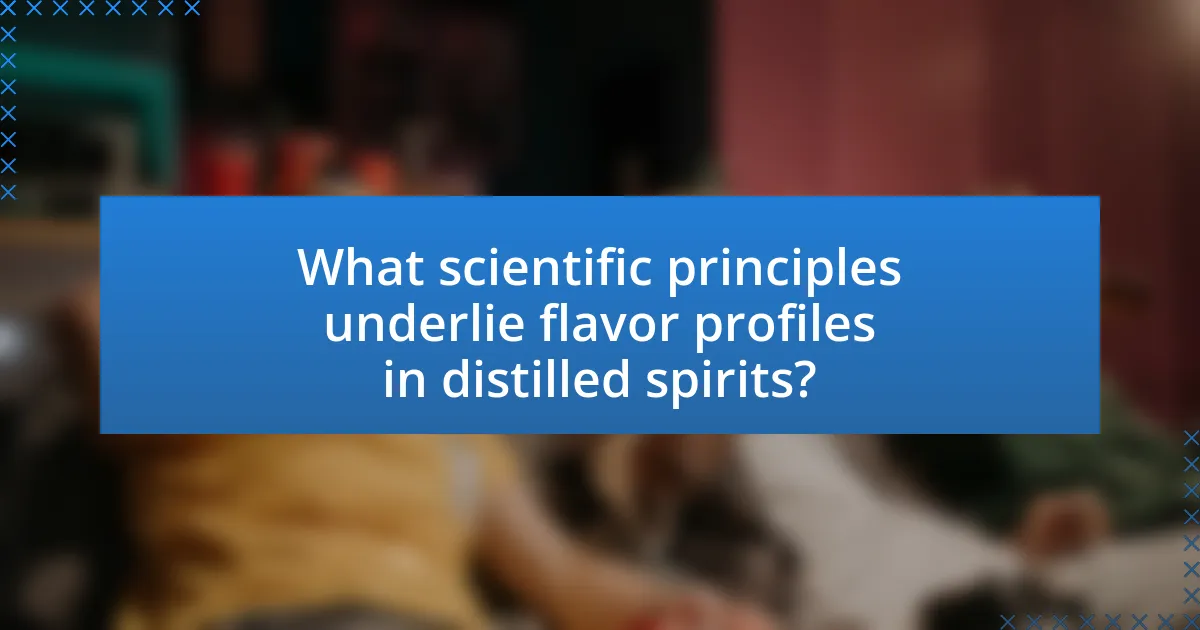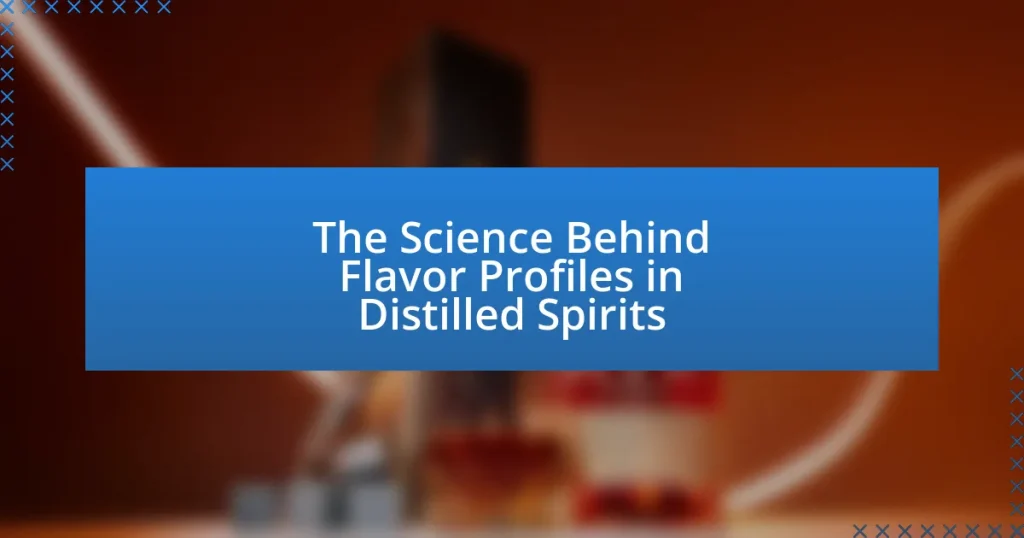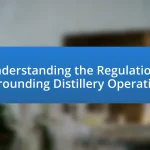The article focuses on the science behind flavor profiles in distilled spirits, detailing how specific combinations of tastes and aromas characterize various spirits. It explores the factors influencing these profiles, including raw materials, fermentation, distillation, and aging processes. Key sections discuss the role of ingredients in flavor development, the impact of distillation techniques, and the significance of aging in barrels. Additionally, the article highlights the importance of flavor profiles for consumer preferences and marketability, as well as the scientific principles and chemical compounds that contribute to the complexity of flavors in spirits. Finally, it offers insights into how consumers can better appreciate and understand these flavor profiles through tasting techniques and educational resources.

What are Flavor Profiles in Distilled Spirits?
Flavor profiles in distilled spirits refer to the specific combination of tastes and aromas that characterize a particular spirit. These profiles are influenced by various factors, including the base ingredients used, the distillation process, aging conditions, and any additional flavoring agents. For example, whiskey may exhibit notes of caramel, vanilla, and oak due to the interaction between the spirit and the wooden barrels during aging. Similarly, gin’s flavor profile often includes botanical elements like juniper, citrus, and herbs, which are derived from the infusion of various plants during production. Understanding these flavor profiles is essential for consumers and producers alike, as they guide the selection and pairing of spirits in culinary and social contexts.
How are flavor profiles created in distilled spirits?
Flavor profiles in distilled spirits are created through a combination of raw materials, fermentation, distillation, and aging processes. The choice of base ingredients, such as grains, fruits, or sugarcane, contributes distinct flavors; for example, barley imparts malty notes in whiskey, while grapes provide fruity characteristics in brandy. During fermentation, yeast converts sugars into alcohol and produces esters and phenols, which enhance the complexity of flavors. Distillation further refines these flavors by separating alcohol from impurities, concentrating desirable compounds. Finally, aging in barrels allows spirits to absorb compounds from the wood, such as vanillin and tannins, which add depth and richness to the flavor profile. This multi-step process ensures that each distilled spirit has a unique and intricate flavor profile shaped by its ingredients and production methods.
What role do raw materials play in flavor profile development?
Raw materials are fundamental in flavor profile development as they provide the primary source of flavors and aromas in distilled spirits. The type of grains, fruits, or botanicals used directly influences the taste, scent, and overall character of the final product. For instance, malted barley contributes a rich, malty sweetness, while corn can impart a lighter, sweeter profile. Additionally, the terroir, or environmental conditions where these raw materials are grown, affects their chemical composition, further shaping the flavor. Studies have shown that variations in soil, climate, and agricultural practices can lead to significant differences in flavor compounds, underscoring the critical role of raw materials in crafting distinct flavor profiles in spirits.
How does the distillation process influence flavor profiles?
The distillation process significantly influences flavor profiles by separating volatile compounds based on their boiling points, which allows for the concentration of desired flavors while removing unwanted elements. During distillation, the initial vapor captures lighter, more aromatic compounds, contributing to the spirit’s complexity and character. For example, in whiskey production, the choice of distillation method—pot still versus column still—affects the retention of flavor compounds; pot stills typically preserve more of the original grain flavors, while column stills produce a cleaner, lighter spirit. This selective evaporation and condensation process is crucial in defining the final taste, as evidenced by the varying flavor profiles of spirits like gin, vodka, and rum, which are all influenced by the specific distillation techniques employed.
Why are flavor profiles important in the world of distilled spirits?
Flavor profiles are important in the world of distilled spirits because they define the sensory experience and influence consumer preferences. Distilled spirits, such as whiskey, vodka, and rum, derive their unique flavors from ingredients, fermentation processes, and aging methods. For instance, whiskey’s flavor can vary significantly based on the type of grain used, the distillation process, and the duration of aging in barrels, which can impart notes of vanilla, caramel, or spice. This complexity not only enhances the enjoyment of the spirit but also guides consumers in making informed choices, as they often seek specific flavor characteristics that align with their tastes. Additionally, flavor profiles play a crucial role in the marketing and branding of spirits, as they help differentiate products in a competitive market, making them essential for both producers and consumers.
How do flavor profiles affect consumer preferences?
Flavor profiles significantly influence consumer preferences by determining the sensory experience associated with a product. Research indicates that consumers often gravitate towards specific flavor profiles that align with their taste preferences, cultural backgrounds, and previous experiences. For instance, a study published in the Journal of Food Science found that individuals tend to prefer sweeter flavor profiles in beverages, which can lead to higher purchase intentions. Additionally, flavor profiles can evoke emotional responses, further shaping consumer choices; for example, familiar flavors may trigger nostalgia, enhancing the likelihood of repeat purchases.
What impact do flavor profiles have on the marketability of spirits?
Flavor profiles significantly influence the marketability of spirits by shaping consumer preferences and driving purchasing decisions. Distinct flavor profiles can differentiate products in a saturated market, attracting specific demographics and enhancing brand identity. For instance, spirits with unique flavor combinations, such as botanical-infused gins or barrel-aged whiskeys, often command higher prices and foster consumer loyalty. According to a 2021 report by the Distilled Spirits Council, products with innovative flavor profiles saw a 15% increase in sales compared to traditional offerings, demonstrating the direct correlation between flavor innovation and market success.

What scientific principles underlie flavor profiles in distilled spirits?
The scientific principles underlying flavor profiles in distilled spirits include the processes of fermentation, distillation, and aging, which influence the chemical composition and sensory characteristics of the final product. During fermentation, yeast converts sugars into alcohol and produces various volatile compounds, such as esters and phenols, which contribute to flavor complexity. Distillation further refines these flavors by separating components based on their boiling points, allowing for the concentration of desirable aromatic compounds. Aging in barrels introduces additional flavors from wood, such as vanillin and tannins, while oxidation and evaporation during this process enhance the overall flavor profile. Studies have shown that these chemical interactions significantly impact the sensory attributes of spirits, confirming the importance of these scientific principles in flavor development.
How do chemical compounds contribute to flavor profiles?
Chemical compounds significantly contribute to flavor profiles by interacting with taste receptors and olfactory senses, creating complex sensory experiences. These compounds, such as esters, phenols, and terpenes, are produced during fermentation, distillation, and aging processes in distilled spirits. For example, esters are responsible for fruity flavors, while phenolic compounds can impart smoky or spicy notes. Research indicates that the specific combination and concentration of these compounds determine the overall flavor profile of a spirit, influencing consumer preferences and perceptions. Studies have shown that variations in chemical composition can lead to distinct flavor characteristics, as seen in different whiskey types, where the presence of specific compounds correlates with flavor descriptors like vanilla, caramel, or oak.
What are the primary chemical compounds found in distilled spirits?
The primary chemical compounds found in distilled spirits include ethanol, water, and various congeners such as methanol, acetaldehyde, and fusel oils. Ethanol, the main psychoactive component, typically constitutes 30-50% of the volume in spirits, while water serves as a solvent and diluent. Congeners, which are byproducts of fermentation and distillation, contribute to the flavor and aroma profiles of the spirits. For example, methanol is present in small amounts and can impart a sweet taste, while acetaldehyde can add fruity notes. Fusel oils, which are higher alcohols, can enhance complexity and richness in flavor. These compounds collectively influence the sensory characteristics of distilled spirits, making them unique in taste and aroma.
How do these compounds interact to create complex flavors?
Compounds in distilled spirits interact through chemical reactions, such as esterification and oxidation, to create complex flavors. These reactions occur during fermentation, distillation, and aging processes, where various compounds like alcohols, acids, and phenols combine to form esters and other flavor compounds. For example, during aging in wooden barrels, compounds from the wood, such as lignin and tannins, react with the spirit, enhancing its flavor profile by adding notes of vanilla, caramel, and spice. This interaction is supported by research indicating that the aging process can significantly alter the chemical composition of spirits, leading to a richer and more nuanced flavor experience.
What role does aging play in flavor profile development?
Aging significantly influences flavor profile development in distilled spirits by allowing chemical reactions to occur that enhance complexity and depth. During aging, compounds such as phenols, esters, and aldehydes interact with each other and with the wood of barrels, leading to the formation of new flavors and aromas. For example, whiskey aged in oak barrels can develop notes of vanilla, caramel, and spice due to the extraction of lignin and vanillin from the wood. Studies have shown that the duration of aging directly correlates with flavor intensity, as evidenced by research published in the Journal of Agricultural and Food Chemistry, which found that longer aging periods resulted in higher concentrations of desirable flavor compounds.
How does barrel type affect the aging process and flavor outcomes?
Barrel type significantly influences the aging process and flavor outcomes of distilled spirits. Different types of barrels, such as American oak, French oak, and others, impart distinct flavors and characteristics due to variations in wood composition, toasting levels, and previous contents. For instance, American oak typically contributes sweeter, vanilla, and coconut notes, while French oak often adds spicier, more complex flavors like clove and nutmeg. The aging process is also affected by the barrel’s porosity, which influences the interaction between the spirit and the wood, allowing for oxygen exchange and evaporation that enhances flavor development. Studies have shown that spirits aged in different barrel types can exhibit measurable differences in chemical compounds, such as vanillin and tannins, which directly correlate to the perceived flavor profile.
What are the effects of environmental factors on aging spirits?
Environmental factors significantly influence the aging of spirits by affecting their flavor profiles, aroma, and overall quality. Temperature fluctuations, humidity levels, and air quality in the aging environment can alter the interaction between the spirit and the wood of the barrels, leading to variations in extraction of compounds such as tannins and vanillin. For instance, higher temperatures can accelerate the maturation process, resulting in a more pronounced flavor profile, while excessive humidity can lead to a loss of alcohol content, impacting the spirit’s balance. Studies have shown that spirits aged in warmer climates often exhibit bolder flavors compared to those aged in cooler regions, highlighting the critical role of environmental conditions in the aging process.

How can consumers better understand and appreciate flavor profiles in distilled spirits?
Consumers can better understand and appreciate flavor profiles in distilled spirits by engaging in sensory evaluation techniques, such as tasting and smelling. These techniques allow individuals to identify specific aromas and flavors, which are influenced by factors like the ingredients used, fermentation processes, and aging conditions. For instance, a study published in the Journal of Agricultural and Food Chemistry highlights that the aging process in oak barrels can impart distinct vanilla and caramel notes to whiskey, enhancing the overall flavor profile. Additionally, consumers can utilize flavor wheels, which categorize various taste and aroma descriptors, to systematically explore and articulate their sensory experiences. This structured approach not only deepens appreciation but also fosters informed discussions about different spirits.
What techniques can be used to evaluate flavor profiles?
Techniques used to evaluate flavor profiles include sensory analysis, gas chromatography, and mass spectrometry. Sensory analysis involves trained panels or consumer testing to assess taste and aroma through systematic tasting methods. Gas chromatography separates volatile compounds in spirits, allowing for the identification of specific flavor components. Mass spectrometry further analyzes these compounds, providing detailed information on their molecular structure and concentration. These methods are validated by their widespread use in food science and beverage quality control, ensuring accurate flavor profile assessments in distilled spirits.
How can tasting notes enhance the understanding of flavor profiles?
Tasting notes enhance the understanding of flavor profiles by providing detailed descriptions of the sensory characteristics of a distilled spirit. These notes articulate specific flavors, aromas, and textures, allowing consumers and producers to identify and appreciate the complexity of the spirit. For instance, a tasting note might describe a whiskey as having hints of vanilla, oak, and spice, which helps individuals recognize these flavors when tasting. This structured approach to flavor analysis is supported by research indicating that descriptive language can significantly influence perception and enjoyment of beverages, as seen in studies published in the Journal of Sensory Studies. By using tasting notes, individuals can better communicate their experiences and preferences, leading to a deeper appreciation of the nuances in flavor profiles.
What are the best practices for tasting distilled spirits?
The best practices for tasting distilled spirits include using a clean glass, observing the color, inhaling the aroma, taking a small sip, and noting the finish. Using a clean glass ensures that no residual flavors interfere with the tasting experience. Observing the color can provide insights into the spirit’s age and ingredients; for example, darker spirits often indicate longer aging. Inhaling the aroma allows the taster to identify various notes, which are crucial for understanding the flavor profile. Taking a small sip helps to assess the initial taste, while noting the finish reveals the lingering flavors and overall balance. These practices are supported by sensory analysis techniques used in the spirits industry, which emphasize the importance of a systematic approach to tasting for accurate flavor assessment.
What resources are available for learning about flavor profiles?
Books, online courses, and tasting workshops are valuable resources for learning about flavor profiles. Notable books include “The Flavor Bible” by Karen Page and Andrew Dornenburg, which provides insights into flavor pairings and profiles. Online platforms like Coursera and MasterClass offer courses on flavor development and tasting techniques, often taught by industry experts. Additionally, tasting workshops conducted by distilleries or culinary schools allow hands-on experience with various spirits, enhancing understanding of flavor nuances. These resources collectively provide a comprehensive foundation for anyone interested in mastering flavor profiles in distilled spirits.
How can educational programs improve knowledge of distilled spirits?
Educational programs can improve knowledge of distilled spirits by providing structured learning experiences that cover the production processes, flavor profiles, and historical contexts of various spirits. These programs often include hands-on workshops, tastings, and lectures from industry experts, which enhance understanding through practical application and sensory evaluation. For instance, programs like the Wine & Spirit Education Trust (WSET) offer comprehensive courses that delve into the chemistry of distillation and the influence of ingredients on flavor, thereby equipping participants with the knowledge to discern and appreciate the complexities of distilled spirits.
What role do tasting events play in flavor profile education?
Tasting events play a crucial role in flavor profile education by providing participants with direct sensory experiences that enhance their understanding of various flavors in distilled spirits. These events allow individuals to sample a range of products, facilitating the identification and differentiation of flavor notes such as sweetness, bitterness, and acidity. Research indicates that experiential learning, such as tasting, significantly improves flavor recognition and appreciation, as participants engage their senses in a structured environment. Furthermore, tasting events often include expert guidance, which helps attendees contextualize their experiences and understand the complexities of flavor profiles, thereby reinforcing their educational value.


